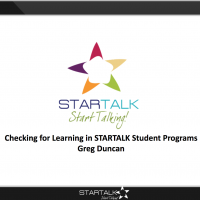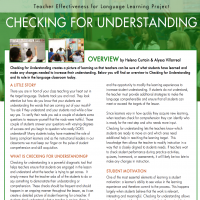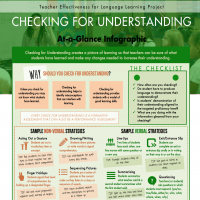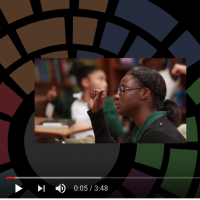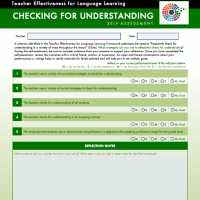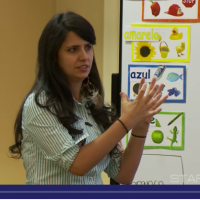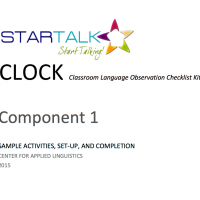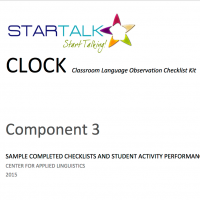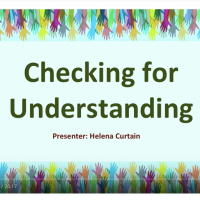Overview Text

- Planning : P7d. I plan to check for understanding in a variety of ways throughout the lesson.
- The Learning Experience : LE4e. I frequently check for understanding in a variety of ways throughout the lesson.
- Performance & Feedback : PF2a. I provide my students with frequent descriptive feedback.
- Performance & Feedback : PF2b. I provide feedback that is close in time to demonstrated performance.
- Performance & Feedback : PF2c. I provide feedback that is supported by evidence from the student performance.
- Performance & Feedback : PF2d. I provide my students with opportunities to compare their current performance to previous performances.
- Performance & Feedback : PF2e. My students and I use rubrics as ways to define quality and to provide feedback.
- Performance & Feedback : PF4a. I analyze evidence of student performance in an ongoing manner.
- Performance & Feedback : PF4b. My students and I modify learning strategies to meet or exceed the performance targets.
This section of the module gives you a chance to determine your current level of understanding of checks for learning. The two (2) pre-assessment scenarios and self-assessment checklists are designed to determine your level of expertise with this topic and how confident are you that you:
- understand the concept of formative checks for learning? (acquire)
- can explain and identify formative checks for learning for each mode of communication? (acquire and observe)
- can identify how formative checks for learning are being used to modify instruction and provide feedback (observe)
- can design and use formative checks for learning for each mode of communication? (apply)
- can use formative checks for learning to adjust instruction as needed? (apply)
- can use formative checks for learning to provide timely feedback to learners? (apply)
Context:
The scenario that is described below gives you a chance to share what you already know about checks for learning. It is possible that you will find that you have little to say or that you feel comfortable answering only part of the question. Give as complete an answer as you can, but know that it is OK to skip the question entirely. this would just be an indication that you are likely to begin this module by doing all or most of the tasks in the acquire section of the module.
Scenario: Imagine that you are interviewing for a teaching position. You have been asked about checks for learning. You want to give a thorough answer. Begin by explaining what a check for learning is. then, give a couple of examples for each mode of communication. Conclude by explaining how you would use checks for learning when planning lessons or giving feedback to learners. Write your response down and do not consult any resources as you draft your answer.
Self-Assess: Review your written response. How confident do you feel about your response? Consider your response as you complete the following self-assessment.
Like the first pre-assessment, the scenario that is described below gives you a chance to share what you already know about using checks for learning. It is possible that you will find that you have little to say or that you feel comfortable answering only part of the questions. Give as complete an answer as you can, but know that it is OK to skip the questions entirely. This would just be an indication that you are likely to begin this module by doing all or most of the tasks in the observe and apply sections of the module.
Scenario: As a follow-up question during the interview, you are asked to describe a lesson that you have taught giving detail on the role that checks for learning played in that lesson. Be specific and comment on how you used the information you gained from the check(s) for learning.
Self-Assess: Review your written response. How confident do you feel about your response? Consider your response as you complete the following self-assessment.
This section of the module offers options for acquiring more information on checking for learning. A brief description is provided for each resource. The overview should provide you with the information you need to select the resources(s) that you feel are best for meeting your needs. Each resource is accompanied by a concept attainment quiz that serves as a check for learning. Once you have completed the quiz, you will be able to see the correct answers and will be directed to explanations for the responses.
There are 4 resources in this section. They are not listed in any intended order. Review the short description provided with each resource and then select that resource that seems best for your situation.
This presentation addresses eight key facets of checking for learning. Those that are most appropriate to this module (Checking for Learning) are listed here. This resource can be viewed online or you can also choose to download a pdf version (available on the first page of the online module) of the guide.
- “What Do We Mean by ‘Checking for Learning’?” provides thoughts about changing our perspective on assessment, moving it from testing and grading to one that students view as more helpful — one that checks on their learning and provides useful information about how to continue to grow in language use.
- “How Do I Use Formative Checks for Learning?” gives numerous examples of formative checks for learning that language teachers can use to monitor and improve student learning.
- “The Importance of Feedback” reminds us that without feedback, learners don’t know what or how to improve, and it provides specific information about how to give appropriate feedback to students.
Author: Helen Curtain and Alyssa Villarreal
This overview provides a brief explanation of checking for learning and will be useful as a quick introduction to the topic or as a brief review. It addresses the following:
- a definition of checking for understanding
- the impact of checking for understanding on student motivation
- checking for learning as formative feedback
- strategies for checking for learning
( )
This is a 2-page overview of checking for understanding from the Teacher Effectiveness for Language Learning Project (TELL) that highlights the important features of the concept while providing sample strategies and helpful tips. This resource will be useful as a quick introduction to the topic or as a brief review.
( )Author: TELL Project
This short video features classroom vignettes, as well as interviews with teachers and students as they reflect on the impact of checking for understanding.
( )- Based on the information presented in this section of the module, is this an area of growth or area of strength for your teaching? Why? What understandings did you have confirmed or challenged?
- What information caught your attention? What was the most meaningful part? What surprised you or what “ah-ha” moments did you have? Why?
- What, if anything made you uncomfortable Why? What will you do to address this discomfort?
This section of the module will allow you to observe teachers as they make use of checks for learning in a classroom setting. A brief description is provided for each resource. The overview should provide you with the information you need to select the resources(s) that you feel are best for meeting your needs. Each video resource is accompanied by a concept attainment quiz that serves as a check for learning. Once you have completed the quiz, you will be able to see the correct answers and will be directed to explanations for the responses.
Author: TELL Project
This self-assessment and feedback tool will allow you to indicate the checking for learning strategies that you currently use. It will also serve as a tool that can be used to reflect on your lessons or while observing a lesson to provide feedback to a colleague on the degree to which checking for learning strategies are being implemented.
( )Author: Marty Chen
This 15-minute video captures a novice language lesson presented to adult learners. The actual lesson starts at 2:27. The instructor focused on use of the target language while making the input comprehensible. The adults in the audience were asked to play the role of novice language learners. Instructors were asked to teach as they would in their classroom and check for learning throughout the lesson. The adult learners were not Chinese speakers. As you watch, attempt to identify the learning target and notice how the teacher checks for learning. Look for evidence that the adult learners are meeting the learning target. You may wish to use TELL: Checking for Understanding Feedback Form as you watch for the first time.
( )Author: Lily Bueno
This 26-minute video captures a novice language lesson presented to adult learners. The actual lesson starts at 1:03. The instructor focused on use of the target language while making the input comprehensible. The adults in the audience were asked to play the role of novice language learners. Instructors were asked to teach as they would in their classroom and check for learning throughout the lesson. The adult learners were not Portuguese speakers. As you watch, attempt to identify the learning target and notice how the teacher checks for learning. Look for evidence that the adult learners are meeting the learning target. You may wish to use the TELL: Checking for Understanding Feedback Form as you watch the first time.
( )- Based on the information presented in this section of the module, is this an area of growth or area of strength for your teaching? Why? What understandings did you have confirmed or challenged?
- What information caught your attention? What was the most meaningful part? What surprised you or what “ah-ha” moments did you have? Why?
- What, if anything made you uncomfortable Why? What will you do to address this discomfort?
Move from Theory to Practice
This section of the module allows you to consider additional ways of checking for learning and gives you the opportunity to design something that could be used in your classroom setting. This section also suggests a summative performance task that draws on the information from each section of the module – acquire, observe and apply.
Author: Center for Applied Linguistics
The Classroom Language Observation Checklist Kit, or CLOCK, is a formative assessment tool designed for K-5 STARTALK teachers to periodically assess students’ speaking and listening comprehension skills based on observations of students’ use of the target language in a classroom setting. The CLOCK can help teachers track student language growth and inform instruction by documenting student performance during different classroom activities. The CLOCK provides important formative assessment data, but it is not a tool to assign a summative global proficiency level.
The CLOCK consists of a User Manual and four components to help STARTALK teachers observe their students during class activities and record what they can do. There are two versions of the CLOCK: one for Chinese teachers that includes Chinese language samples and a generic version in English for teachers of other languages. While each of the components of CLOCK is useful when assessing student learning, components 1 and 3 provide an opportunity to consider how an instructional activity might be used as a check for learning. Review the information in each component and complete the following checks for learning.
Component 1: Check for Learning – Sample Activities, Set-up and Completion
( )Author: Center for Applied Linguistics
The Classroom Language Observation Checklist Kit, or CLOCK, is a formative assessment tool designed for K-5 STARTALK teachers to periodically assess students’ speaking and listening comprehension skills based on observations of students’ use of the target language in a classroom setting. The CLOCK can help teachers track student language growth and inform instruction by documenting student performance during different classroom activities. The CLOCK provides important formative assessment data, but it is not a tool to assign a summative global proficiency level.
The CLOCK consists of a User Manual and four components to help STARTALK teachers observe their students during class activities and record what they can do. There are two versions of the CLOCK: one for Chinese teachers that includes Chinese language samples and a generic version in English for teachers of other languages. While each of the components of CLOCK is useful when assessing student learning, components 1 and 3 provide an opportunity to consider how an instructional activity might be used as a check for learning. Review the information in each component and complete the following checks for learning.
( )- How was your thinking challenged as you moved from acquiring and observing to applying what you had learned?
- Consider what actions you’ll take next as a result of your learning and reflection. Identify at least one next step you will take in your teaching situation.
- How will you know that you have been successful in your implementation of checks for learning?
- What key learning should be shared with others?
Additional Resources
Author: Ayano Suzuki
This 16-minute video presentation developed by Ayano Suzuki, a practicing Japanese teacher, provides an explanation of “Checking for Understanding” in a world language classroom as well as practical tips from the teacher’s own classroom. Alan discusses 3 key aspects of checking for understanding:
- What is checking for understanding?
- How often do I check for understanding?
- How can I check for understanding?
( )
Author: Helena Curtain
This 20-minute video provides an overview to the concept of “Checking for Understanding” in a world language classroom. Helena Curtain discusses 4 key aspects of checking for learning:
- What is checking for learning?
- Why is it important to use checks for learning?
- What types of responses can teachers elicit from students?
- What are some strategies teachers use to check for learning?
This presentation addresses eight key facets of checking for learning. Those that are most appropriate to this module (Checking for Learning) are listed here. This resource can be viewed online or you can also choose to download a pdf version (available on the first page of the online module) of the guide.
- “What Do We Mean by ‘Checking for Learning’?” provides thoughts about changing our perspective on assessment, moving it from testing and grading to one that students view as more helpful — one that checks on their learning and provides useful information about how to continue to grow in language use.
- “How Do I Use Formative Checks for Learning?” gives numerous examples of formative checks for learning that language teachers can use to monitor and improve student learning.
- “The Importance of Feedback” reminds us that without feedback, learners don’t know what or how to improve, and it provides specific information about how to give appropriate feedback to students.
This resource addresses eight key facets of checking for learning. Those that are most appropriate to this module are listed here. This resource can be viewed online or you can also choose to download a pdf version of the guide. The pdf version is available as a download on the first page of the online module.
“What Do We Mean by ‘Checking for Learning’?” provides thoughts about changing our perspective on assessment, moving it from testing and grading to one that students view as more helpful–one that checks on their learning and provides useful information about how to continue to grow in language use.
“How Do I Use Formative Checks for Learning?” gives numerous examples of formative checks for learning that language teachers can use to monitor and improve student learning.
“The Importance of Feedback” reminds us that without feedback, learners don’t know what or how to improve, and it provides specific information about how to give appropriate feedback to students.
( )This resource addresses eight key facets of checking for learning. Those that are most appropriate to this module are listed here. This resource can be viewed online or you can also choose to download a pdf version of the guide. The pdf version is available as a download on the first page of the online module.
“What Do We Mean by ‘Checking for Learning’?” provides thoughts about changing our perspective on assessment, moving it from testing and grading to one that students view as more helpful–one that checks on their learning and provides useful information about how to continue to grow in language use.
“How Do I Use Formative Checks for Learning?” gives numerous examples of formative checks for learning that language teachers can use to monitor and improve student learning.
“The Importance of Feedback” reminds us that without feedback, learners don’t know what or how to improve, and it provides specific information about how to give appropriate feedback to students.
( )
